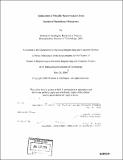Fabrication of metallic nanostructures from sputtered nanocluster precursors
Author(s)
DelHagen, William S
DownloadFull printable version (7.768Mb)
Other Contributors
Massachusetts Institute of Technology. Dept. of Electrical Engineering and Computer Science.
Advisor
Joseph Jacobson.
Terms of use
Metadata
Show full item recordAbstract
This thesis studies the morphological and electrical properties of copper nanocluster devices generated by DC magnetron sputtering and annealed at temperatures up to 1100 C. At each annealing step, the resistivity of the cluster device was measured and electron micrographs were taken of the cluster depositions. Nanoclusters have been studied for decades because of the unique properties they display that are somewhere between bulk materials and atomic behavior. Recently, techniques have been explored to exploit the depressed melting point effect that small clusters exhibit to fabricate integrated circuit components. These techniques have only been attempted with colloidal solutions of passivated nanoclusters. The purpose of this thesis is to undertake an investigation of the melting point of clusters generated from a sputter source without passivation. Differing from passivated clusters, resistivity of copper cluster films was found to increase with annealing temperatures until about 900 degrees C but drop to one order of magnitude greater than bulk resistivity after annealing at 1100 C.
Description
Thesis (M. Eng.)--Massachusetts Institute of Technology, Dept. of Electrical Engineering and Computer Science, 2004. Includes bibliographical references (p. 73-74).
Date issued
2004Department
Massachusetts Institute of Technology. Department of Electrical Engineering and Computer SciencePublisher
Massachusetts Institute of Technology
Keywords
Electrical Engineering and Computer Science.